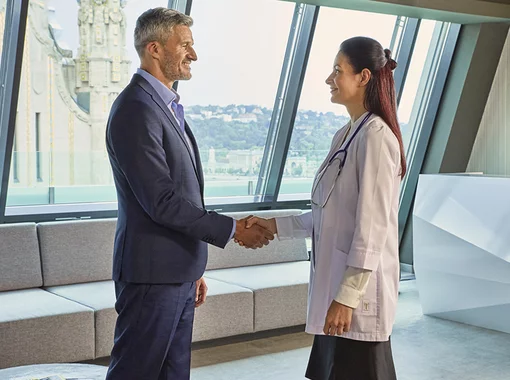This medical field deals with the diagnosis and treatment of diseases of the organs located in the head and neck region and there forming a close unit: diseases of the ear, nasal and paranasal sinuses, oral cavity, pharynx, larynx, trachea, salivary glands and, to some extent, esophagus and neck.
WHAT EAR-NOSE-THROAT SERVICES DO WE PROVIDE AT OUR PRIVATE HOSPITAL?
Specialist EAR-NOSE-THROAT services
WHEN SHOULD YOU CONSULT AN EAR-NOSE-THROAT SPECIALIST?
- In cases of acute inflammation, fever, pain, swallowing or breathing complaints
- For prolonged hoarseness, nasal congestion, nasal discharge
- Swallowing and aural disorders
- Allergic rhinitis - bilateral watery runny nose, nasal congestion, itchy nose, eyes or throat, watery eyes
- Ear pain, blocked ears, hearing loss, dizziness, tinnitus
- Snoring
- Throat complaints - hoarseness, foreign body sensation, cough
- Swelling and pain in the head and neck regions
- Swelling of the salivary glands, pain, dry mouth
- Sensation of lumps in the throat, hacking, nightly cough
More information about our ear-nose-throat specialty >>
OTOLARYNGOLOGICAL SURGERIES
Our specialists use mainly pharmacological and alternative procedures in the ear-nose-throat outpatient care, but they also have extensive experience in the field of surgical interventions.
Our premium inpatient department has 3 operating rooms and 19 patient rooms with 25 beds to meet all our patients’ needs. The highest professional standards together with our exclusive environment help you heal in safety and tranquility.
Our hospital offers both one-day and multi-day surgical care.
Surgical operations are always preceded by a detailed and careful examination. The goal of the examination is to get the patient into the operating room in the best possible condition, so that the healing is faster and the number of complications is significantly reduced.
Our main otolarynological surgeries:
- Functional endoscopic sinus surgery (FESS)
- Snoring examination (sleep endoscopy)
- Nasopharyngeal tonsil surgery (adenoidectomy)
- Deviated septum surgery
- Tonsil surgery (tonsillectomy)
- LAUP (laser-assisted uvulopalatoplasty) - soft palate plasty
- LAUP (laser-assisted uvulopalatoplasty) - mucotomy
More information about our otolarynological surgeries >>
WHY CHOOSE DR. ROSE PRIVATE HOSPITAL?
- Highly qualified specialists. In our urology department, we have highly skilled, experienced doctors and the latest diagnostic equipment.
- Personalized care for all our patients. We not only focus on medical history and family history of similar diseases, but also on the individual needs of the patient, and develop an appropriate treatment plan accordingly.
- An empathetic approach. From the first examination to the therapeutic period, we treat our patients with patience and always provide detailed and transparent information about the diagnosis and treatment options.
For all your ear-nose-throat questions, please feel free to contact the doctors at Dr. Rose Private Hospital.
